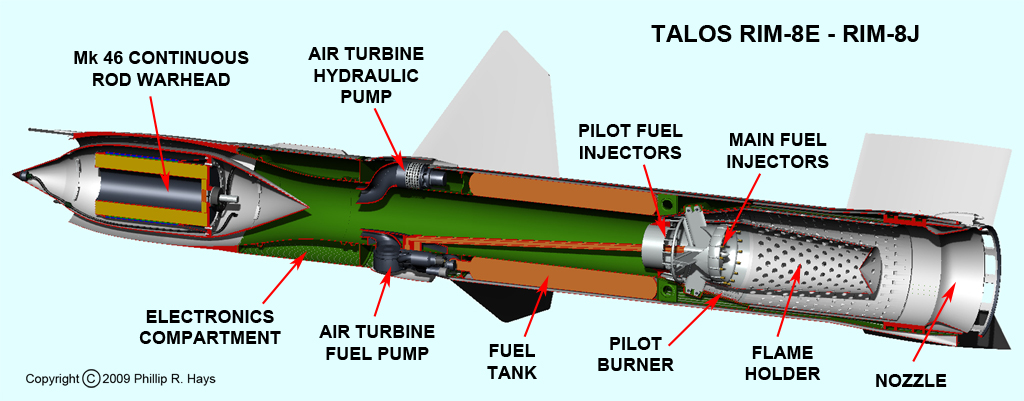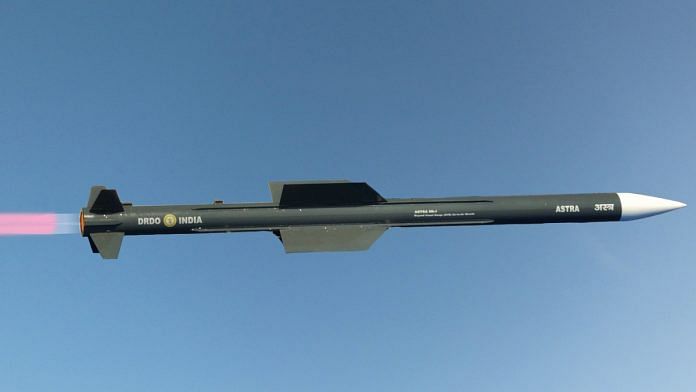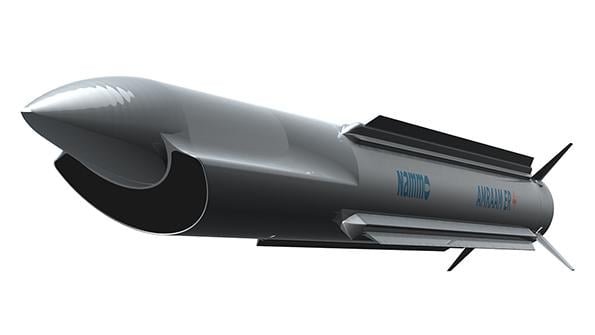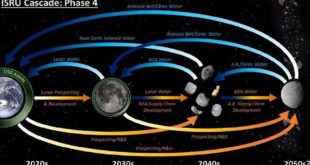Traditional missiles powered by rocket motors typically carry both fuel and oxidizer. An air-breathing ramjet missile can dispense with the separate oxidizer payload, reducing the size of a propulsion package. Thanks to ramjets, smaller missiles use that space for other things, like a bigger warhead or more fuel. Ramjets, according to NASA, are the “ideal propulsion system” for “high supersonic” or hypersonic flight. As a missile or aircraft flies along, it compresses the air in front of it. This is known as ram pressure. Rather than force their way through this pressure wave, ramjets suck it in, using the abundant oxygen in it as an oxidizer. The air is mixed with burning fuel and then pushed out a nozzle in the rear, creating thrust.
Ramjets have made somewhat of a comeback in military technology recently especially in air-to-air role by missiles such as the MBDA Meteor . Ramjets were first developed for use on missiles in the late 1940s as a technology to allow missiles to sustain supersonic speeds for long durations and powered many anti-air missiles throughout the Cold War, more recent designs eschewed them in favor of multi-stage rocket boosters or simply more powerful rockets. First gen missile ramjets such as those featured on the RIM-8, 2K12, 2K11, and Sea Dart all relied on liquid fuel in their ramjets, so they had to be very very large.

The new ramjets use solid fuel instead, allowing them to be more compact. They also have a limited “throttling” capability, allowing the missile to control the rate at which it uses fuel.
Countries are now racing to develop long range AAMs. The U.S. Army is developing long-range missiles and artillery to extend its reach for great power competition. US Air Force which awarded a half-billion-dollar contract to Raytheon long range air-to-air missile, capable of hitting enemy planes from 100 miles (160 kilometers) away. The Meteor, a new European equivalent, may be even more deadly. But China’s latest offering, the PL-15, has a largest range than either.
USAF has released a request for information (RFI) in May 2020 as part of a broad search of new long-range air-to-air missile technologies. The ideas would inform the service’s technology roadmap. Interest in beyond-visual-range missiles come as China’s air-to-air PL-15 missile, introduced in 2018, has outdistanced the range of the USAF’s currently fielded AIM-120. Beijing’s weapon reportedly has a reach of 108nm (200km). Fears of being outgunned has sparked an arms race. To catch up in the short-term, the USAF is investing in the AIM-260. Details on that missile are sparse and the service declines to comment on its progress. The AIM-260 is reportedly scheduled to reach initial operating capability in 2022.
One of the important technology in long range AAMs is new propulsion technology. Most current missiles use a booster/sustainer configuration with solid or liquid propellants. The booster stage propels them to top speeds after which the sustainer sustains the missile velocity for some time before complete burnout after which they glide towards the target. While this is a simple and tested means, it has limitations of maximum engagement ranges especially against manoeuvring targets which can bleed the energy of conventional missiles.
To improve endgame manoeuvring missiles started incorporating multi-pulse rocket motors like the ones in the Astra MK1 and Rafael Stunner, the second pulse doesn’t fire simultaneously but rather at the terminal stages when the seeker has locked onto the target, greatly enhancing endgame manoeuvrability. The MBDA meteor missile broke the impasse by incorporating a Throttleable Ducted Rocket (TDR) version of the ramjet made by the famous propellant manufacturer Bayern-Chemie of Germany. The TDR acts like an extended sustainer with variable thrust in a solid propellant but can sustain thrust for far longer periods as it gets the oxidiser from the air, instead storing it as in solid fuelled missiles.
Artillery shells are another application where the continual thrust of a ramjet engine is a desirable feature. Unlike current rocket-assisted projectile shells, which suffer from the same drawbacks of only being able to provide thrust for a relatively small time, ramjet shells can provide a “boost” for much longer.
SFDR Technology
Although rocket motors have the edge in terms of overall speed, they experience a characteristic energy drop-off towards the limit of their range. Ramjets, by contrast, maintain their peak energy state for longer, delivering power throughout the flight, providing a high – though slightly slower – average speed and long ranges over a wide operational envelope, from sea level to high altitude.
The ramjet propulsion system depends only on its forward motion at supersonic speed to compress intake air, the engine flow-path components have no moving parts. Consequently, it has inherent simplicity, reliability, light weight, and high-speed flight capability not possible with other air-breathing engines. These attributes make the ramjet a good choice for propelling medium-caliber cannon ammunition at supersonic speed. In a solid-fuel ramjet, air from the inlet flows through the “pipe” of fuel (also known as a “fuel grain”), which burns along its length.
Unlike solid rocket propellant whose formulation is approximately 20% fuel and 80% oxidizer, the solid ramjet fuel is 100% fuel and obtains oxidizer from air, with the result being approximately four times the specific impulse (the product of thrust and time divided by propellant weight) as compared to solid rocket propellant. The higher specific impulse translates to either longer range for a given payload weight and volume, greater payload to a given range, a smaller size to a given range, or a combination of all three compared to a solid rocket motor.
Unlike traditional rocket motor, SFDR can throttle its engine during different phases of flight especially while approaching its target it can throttle up and able to maneuver and attack even rapidly maneuvering targets.
Propulsion system on the Meteor BVRAAM
The Meteor missile is powered by a solid fuel variable flow ducted rocket (ramjet) supplied by Bayern-Chemie. The ramjet provides the Meteor missile with a capability to maintain consistent high speeds. This ability helps the missile to chase and destroy fast moving flexible targets. According to the manufacturers, Meteor has between three and six times the kinematic performance of current similar types of air-to-air weapons – something made possible by its unique solid fuel, variable-flow, ducted ramjet propulsion system.

Unlike traditional rocket motor, Meteor can throttle its engine during different phases of flight especially while approaching its target it can throttle up and able to maneuver and attack even fast maneuvering targets.vNot only does this mean the Meteor will have more energy to maneuver during the endgame of the engagement, but this capability also drastically increases the size of the missile’s “no escape zone.” Basically, The Meteor includes an electronics and propulsion control unit (EPCU). The EPCU adjusts the rocket’s air intake and duct covers based on the cruise speed and the target’s altitude. The EPCU observes the distance and fuel level in the rocket and adjusts the throttle of the rocket. This feature of the EPCU helps the missile to manage its fuel system.
India integrating the current 110 km version of the Astra Mk 1 and developing 160 Km version
India is working on an extended range of the indigenous beyond-visual-range (BVR) air-to-air missile ‘Astra’ (Sanskrit/Hindi for a launched weapon), which will enable it to strike enemy targets 160 km away, without getting out of its own airspace. The development comes even as work is on to integrate the current 110 km version of the Astra Mk 1 on board the Indian Air Force’s MiG-29 and Light Combat Aircraft ‘Tejas’ Mk 1, and the Indian Navy’s MiG-29K aircraft. The Astra Mark 1 is already integrated with the IAF’s Su-30 MKI fighters, and the production process — by state-owned Bharat Dynamics Limited — has begun.
In July this year, the defence ministry formally sanctioned the purchase of 248 Astra missiles, including 48 for the Navy, after a successful September 2019 trial in which it hit a target 90 km away.

In 2018 India successfully carried out the flight test of Solid Fuel Ducted Ramjet (SFDR) propulsion based missile, the Defence Ministry said The technology demonstrator flight test was conducted from the Launch Centre-III of Integrated Test Range at Chandipur in Odisha. “The flight test met all the mission objectives. The technology of nozzle less booster has been successfully demonstrated in the mission for the first time in the country,” an official statement said. The defensive missile flew in its intended trajectory at speed of Mach 3 (thrice the speed of sound) and met all mission objectives.
India’s new surface-to-air missile is powered by Solid Fuel Ducted Ramjet (SFDR) achieved a speed of Mach 3 during its first test flight in May 2018. SFDR technology is jointly developed by India and Russia. Unlike traditional rocket motor, SFDR can throttle its engine during different phases of flight especially while approaching its target it can throttle up and able to maneuver and attack even rapidly maneuvering targets.
The new technology will help both surface-to-air and air-to-air missiles perform better and enhance their strike range, making the weapons more lethal. Now India can have the fastest long-range missiles in the two categories, providing full-fledged and multi-layered aerial protection from hostile attacks.
For the second version of the Astra missile, called Mark 2, the Defence Research and Development Organisation (DRDO) is working on dual-pulse rocket motor to extend the range up to 160 km by May 2022, sources in the defence and security establishment told ThePrint. Work is also going on to replace the Russian radio frequency (RF) seekers’ on the missile with indigenous ones, a source said. “Three air launch and captive flight tests have been completed with indigenous RF seekers. The indigenous seeker will be proven by June 2021. Subsequently, Astra Mk-1 & Mk-2 missile will be using the indigenous seeker in production,” the source said.
Air Force Seeking Faster, Longer-Range Air-to-Air Missiles
The US Air Force (USAF) is asking aerospace manufacturers for experimental ideas to use in its future long-range air-to-air missiles. The ideas could be incorporated into missile designs that come after the service’s current Raytheon AIM-120 Advanced Medium-Range Air-to-Air Missile and the in-development Lockheed Martin AIM-260 Joint Advanced Tactical Missile. Generally, the USAF wants ideas for weapons that significantly exceed the range of currently fielded systems, while minimising flight time.
For example, the USAF is interested in hearing about ideas for lifting body missile airframe designs. This is a radical departure from the tube-and-fins profile that have characterised air-to-air missiles for decades. Lifting body vehicles are wingless aircraft that gain lift from the aerodynamic shape of their fuselage. Two well-known examples include the teardrop-shaped X-24A and the flatiron-shaped X-25B. Those rocket-powered gliders were jointly developed by NASA, the USAF and Martin Marietta in the 1960s and 1970s to show the ability to manoeuvre and land a wingless spacecraft after re-entering the Earth’s atmosphere from outer space.
“The use of a lifting body missile airframe has the potential to increase the range of a system by optimising flight profile to take advantage of the airframe’s shape,” says Weber. “However, there are potential concerns with regard to manoeuvring capability in comparison to a cylindrical missile. The air force doesn’t currently have any systems like this.” Some of the aerodynamic principles that were developed and tested with previous lifting body aircraft are transferable to various Mach regimes for air-to-air missiles, says the USAF. “Lifting bodies offer a lot of potential for increased range and also novel control systems,” says Weber. “If you can control your missile without a lot of additional drag you can go further.” Departing from conventional missile shapes might have other benefits.
“If you don’t stick to the tubular missile constructs, maybe you can have increased loadout in some cases, depending on the shapes that you could come up with,” says Weber. “There’s definitely a trade space for novel airframes if we, in the future someday, move away from the traditional missile shape.”
The USAF is also interested in exploring morphing missiles. Morphing aircraft change shape in different phases of flight to optimise aerodynamic performance. NASA has built several morphing wings in recent years to demonstrate the concept. “That’s also an area that sounds like science fiction, but there’s been some good research done to suggest that perhaps that’s something that we could look to the future for,” says Weber. Weber cautions that the USAF is not just interested in revolutionary concepts, but also wants to hear about ideas for evolutionary improvements to missile design. For example, the service is looking for new proposals around a fighter aircraft’s carriage and release system.
Fifth-generation fighters, such as the Lockheed Martin F-35 and F-22, have internal weapons bays to reduce their radar signatures. However, that also limits the number of missiles they can carry. The USAF is looking for novel ways to cram more missiles into weapons bays. The service wants missile lengths not to exceed 4m (13.1ft).
In 2019, Lockheed revealed that it had developed a new weapons rack, called Sidekick, that would allow the F-35 to carry six missiles instead of four.
In addition to increased storage capacity, the air force wants to hear about new ideas for holding missiles in the weapons bay.
“When we’re talking about long ranges, you really need that weapon to be as clean as possible,” says Weber. “What I mean is free of bumps or roughness, surfaces like lugs that you would use to hold that missile onto a carrier.”
The USAF is interested in hearing about ideas for retractable lugs or lugs that shear off, as well as entirely different ways of holding missiles that do not incorporate mounting extrusions which create aerodynamic drag and result in reduced range.
Propelling missiles faster and further will likely require new propulsion systems. And so, the USAF is interested in single-stage solid rocket motors, multi-stage solid rocket motor and jet engines. More specifically, the request for information mentions interest in multi-pulse solid rocket motor, throttle-ability, new propellants, as well as novel grain configurations and cases and liners. Thrust vectoring is also of interest, says Weber. The USAF also wants smarter missiles. It is looking for improvements to guidance, navigation and control systems, including optimised guidance algorithms, and compact M-Code GPS. To power those electronics, it is looking for advanced batteries and ultra-capacitors.
Ultimately, the service wants its next-generation missiles to be networked and is coordinating closely with its Advanced Battle Management System experiment so that the weapons are integrated into a future battlefield network. “Our success in the future will be largely dependent on our ability to connect and have data flow all across the system and all the way to the edge. That means all the way to the weapon,” says Weber. “That’s why we include that type of technology in this very general RFI. The future is about how we connect.”
Nammo’s ramjet engine.

According to Air Force Technology, Norwegian defense contractor Nammo has completed its first round of ramjet motor testing with 150 successful tests. The second round will consist of shooting ramjet-powered 155-millimeter artillery rounds. Nammo claims traditional rocket engines are 20 percent fuel and 80 percent oxidizer. With a ramjet engine, that ratio changes to one hundred percent fuel and zero percent oxidizer, leading to dramatic increases in flight time and range.
Nammo claims traditional rocket engines are 20 percent fuel and 80 percent oxidizer. With a ramjet engine, that ratio changes to one hundred percent fuel and zero percent oxidizer, leading to dramatic increases in flight time and range. The difference between rocket motors and ramjets is plainly obvious in the company’s plans for the Evolved Sea Sparrow (ESSM) surface-to-air missile. In September, Defense News reported Nammo plans to retrofit the ESSM with a ramjet. Existing rocket motor-powered ESSMs have a range of 50 kilometers (31 miles). With a ramjet engine, the company believes an upgraded ESSM would have a range of over 400 kilometers (248 miles).
Ramjet artillery rounds will also see big gains in range. Traditional unpowered artillery rounds coast along on ballistic arcs, slowly losing speed as they travel towards their targets. A ramjet round will not only reach farther but fly faster, particularly towards the end of the arc. Adding a ramjet to a 155-millimeter howitzer shell will mean less internal volume for an explosive payload, but the gain in range will be well worth it. Nammo claims its ramjet howitzer shell will reach a distance of 60 miles, compared to 15 miles for standard howitzer shells. This content is created and maintained by a third party, and imported onto this page to help users provide their email addresses.
Purdue startup develops high-performance solid rocket propellant
Adranos Inc., a Purdue University-affiliated company developing a high-performance, solid propellant for long-range missile and space launch systems, has won the Army’s inaugural xTechSearch competition, besting more than 350 companies in the months long competition. Adranos is developing a propellant called ALITEC that uses an aluminum, lithium alloy that has more thrust and is less corrosive than traditional solid propellants. Brandon Terry discovered the innovative rocket fuel while working on his Ph.D. at Purdue. “This is a significant improvement over traditional fuels, and the funding will help us take our technology to the next level,” said Chris Stoker, who co-founded Adranos with Terry.
Adranos officials say the novel propellant has more thrust and is less corrosive than traditional solid propellants. ALITEC would also virtually eliminate hydrochloric acid produced by other propellants. The acid contaminates the environment, corrodes ground-based equipment and damages sensitive satellite components.
The propellant could be used by the Army, Navy, Air Force, NASA, and other Department of Defense agencies as well as U.S. allied nations. Adranos says its propellant is better because it would dramatically increase the range of a missile, giving military personnel a competitive advantage and making resupply missions safer. It also could reduce the missile smoke signature, making it more difficult to detect.The more efficient propellant also could allow the Army to use smaller, more affordable missiles because each missile would need less propellant and could allow a craft to carry more missiles, increasing the number of possible strikes.
SPARC Research Awarded Navy Contract for High-Speed Missile Technology Development in Dec 2020
SPARC Research has been awarded a base contract for the Missile Integration Science and Technology – Ramjet (MISTR) program from the Office of Naval Research.
The Solid Fuel Ramjet (SFRJ) is a promising high-speed ramjet propulsion system with many tactical advantages. It has been in development for years but has yet to be implemented in an operational weapon system. The MISTR program has been structured to examine the barriers to adoption of the SFRJ and to develop a structured Science and Technology program aimed at elevating the state of readiness. The ultimate goal is to make the SFRJ a viable option for advanced warfighting capability.
The SPARC Research team represents decades of high-speed propulsion experience and is uniquely qualified to conduct this effort for the Navy. According to SPARC Research’s President Dr. Patrick Hewitt, “The MISTR program is well-timed to support emerging long-range supersonic and hypersonic missile propulsion needs for the warfighter. Almost across the board, user requirements seek to increase missile range and speed, and the SFRJ is one of the most attractive propulsion options available – if a number of technology challenges can be addressed.”
The MISTR program will benefit from a large database of prior SFRJ research activities. This history will be complimented with additional tasks under the contract as needed to enable the SFRJ to compete favorably for future propulsion requirements.
References and Resources also include:
https://nationalinterest.org/blog/buzz/why-us-military-should-fear-ramjets-28422?page=0%2C1
https://www.popularmechanics.com/military/research/a29490080/ramjet-engine-missiles/
 International Defense Security & Technology Your trusted Source for News, Research and Analysis
International Defense Security & Technology Your trusted Source for News, Research and Analysis


